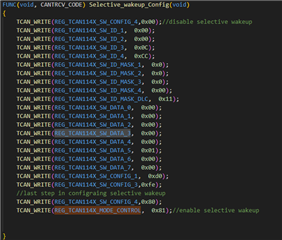Tool/software:
Hello Team,
I'm using Can Transceiver "TCAN1145-Q1" and configure speed of CAN to be 500K and CANFD 2000K. When using this TCAN1145-Q1 in Partial Network and send "NM" message - sleep request to ECU "PNC not valid " -, Can Transceiver is going to sleep mode and INH pin set to low. But when we set PNC correctly from CANOE (send valid 'NM' message to) the CAN transceiver. It does wakeup and INH pin is set to high after 10s ('NM' message has to be sent repetitively 10 times to wakeup. 1 'NM' message every 1s) . I need to know why do I need to wait 10s to set INH pin High and wakeup the CAN transceiver ? and how to fix this ?
Note:
- We send NM message through CAN not CAN FD
- attached below the configuration of selective wakeup. 'Selective_wakeup_Config' function is called to sleep the CAN transceiver

Thanks
Hossam Afifi

